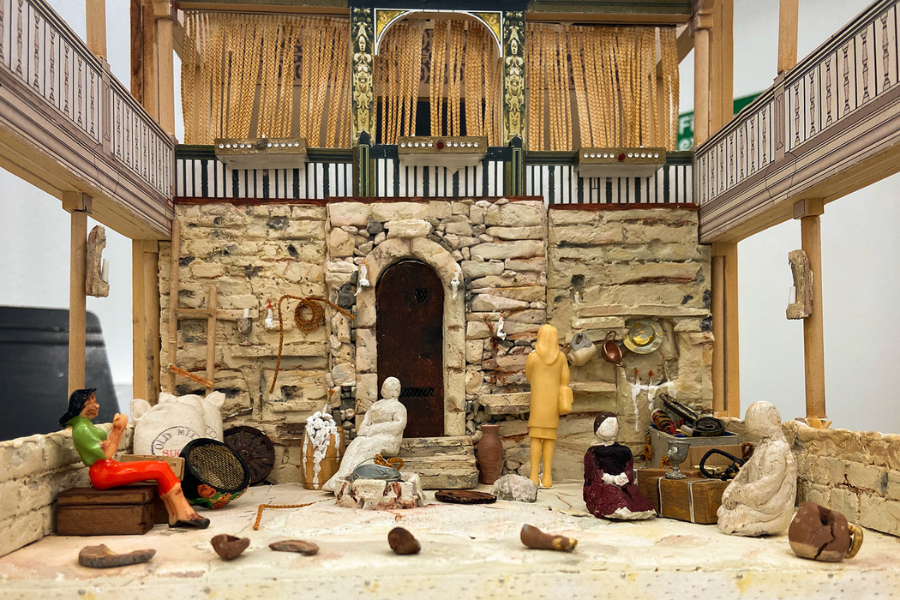Posted: 19 December 2022
Designer Rosa Maggiora shares her inspiration behind Hakawatis: Women of the Arabian Nights

In the dungeon of a large palace, five women – Fatah, Akila, Zuya, Wadiha and Naha – await their marriage to a tyrant King. Since his first wife was unfaithful to him, the King weds, beds, and beheads a wife every day. His current wife, Scheherazade, hopes to prolong her life by telling him stories, passed on by the five brides-to-be. Inspired by One Thousand and One Nights, Hakawatis: Women of the Arabian Nights follows the five storytellers as they become Hakawati (storytellers) – not just for the king, but for each other.
Designer Rosa Maggiora shares the inspiration behind her creative vision for this exciting new show performed in the Sam Wanamaker Playhouse.
‘The folktales were originally told in Persia, Arabia, and India before they became the basis for the tales’ in One Thousand and One Nights, reveals Rosa. ‘I looked at lots of different images including early and contemporary paintings, illustrations, videos and photos that have been influenced by the tales, or that were inspired by the varying countries, their culture, crafts, and landscapes.’
For the costumes, Rosa found ‘original fabric from North Africa, from Palestine’, examining unique patterns and how to create them to integrate the characters’ clothes into their stories. As Director Pooja Ghai points out, there are ‘different layers that those characters have in accordance with their journey and how they came here and how they came to be these brides’.
For the costumes, Rosa found ‘original fabric from North Africa, from Palestine’, examining unique patterns and how to create them to integrate the characters’ clothes into their stories. As Director Pooja Ghai points out, there are ‘different layers that those characters have in accordance with their journey and how they came here and how they came to be these brides’.

For the set, Rosa took inspiration from the Sam Wanamaker Playhouse itself: ‘[it] gave me the idea of the king’s palace above because of the beautiful rich architecture of the musician’s gallery with its gold tinges’, leading Rosa to ‘the idea of the women being imprisoned in a dungeon below a large palace, carved out of stone in the middle of a vast desert land’, and making the set an ‘underground stone dungeon, that may store old relics from the King’s travels, or simply be the palace storage room’ which ‘brings opportunity for the women to do things to pass time around their telling of the stories’.

Another inspiration for the set came from one of the world’s most famous archaeological sites. As Writer Hannah Khalil explains, ‘one of Rosa’s pictures that she brought into rehearsals was the inside of Petra’ – a city partly-built and partly-carved out of stone in Jordan, recognisable as the site of the Holy Grail in Indiana Jones and the Last Crusade – ‘and even though it’s very ornate on the outside, in the inside it’s just a room carved out of stone.’ The intricate stone walls on the set for Hakawatis help to create ‘a space that is very elemental’ for Director Pooja Ghai.
Like all shows performed in the Sam Wanamaker Playhouse, Hakawatis is lit with candles, creating a unique theatrical atmosphere unlike anything else. As Rosa explains, ‘the candlelight is such an integral part of the world that the story [inhabits]’. Candles have a particular significance in Hakawatis: each of the five characters hold the candle of the storyteller, as they share tales to give to Scheherazade and please the tyrant King. ‘The candlelight shows the only light they have to survive and exist in’, says Rosa, ‘the action of lighting and extinguishing of candles, as well as used candles piling up […] will help to enable the showing of passing of time over 1001 nights.’
Ultimately though, ‘it’s a timeless place’, says Pooja, ‘the world of this place is very much the world of these women’. Hakawatis ‘isn’t set in any one time or place’, agrees Hannah, ‘it could be here and now, it could be in the future, it could be in the past’. As Rosa says, the stories are ‘embedded with the historical and contemporary life experiences shared by the women through their storytelling power.’